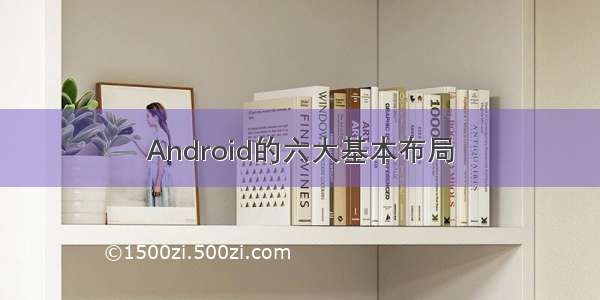
Android中常用的布局方式有以下几种:
线性布局LinearLayout
相对布局RelativeLayout
表格布局TableLayout
层布局FrameLayout
绝对布局AbsoluteLayout
网格布局GridLayout
用的相对较多的是线性布局和相对布局。接下来重点演示这两种布局
其中,表格布局是线性布局的子类。网格布局是android 4.0后新增的布局。
(一)线性布局LinearLayout
线性布局中最重要的属性:orientation
horizontal(水平布局)和vertical(垂直布局)两种方式
属性名
orientation 布局方式,有horizontal(水平布局)和vertical(垂直布局)两种方式
id 组件名称
layout_width 该组件的宽度
layout_height 该组件的高度
layout_weight 权重
layout_gravity 该组件(在父容器)中的对齐方式
gravity 该组件所含子组件在其内部的对齐方式
background 设置背景图片或填充颜色
效果图
<?xml version="1.0" encoding="utf-8"?><LinearLayout xmlns:android="/apk/res/android"android:layout_width="match_parent"android:background="@color/gray"android:layout_height="match_parent"android:orientation="vertical"><LinearLayoutandroid:layout_marginTop="20dp"android:layout_width="match_parent"android:orientation="horizontal"android:layout_height="wrap_content"><TextViewandroid:text="权重1"android:layout_width="0dp"android:layout_weight="1"android:layout_height="wrap_content"/><TextViewandroid:text="权重2"android:layout_width="0dp"android:layout_weight="1"android:layout_height="wrap_content"/><TextViewandroid:text="权重3"android:layout_width="0dp"android:layout_weight="1"android:layout_height="wrap_content"/><TextViewandroid:text="权重4"android:layout_width="0dp"android:layout_weight="1"android:layout_height="wrap_content"/><TextViewandroid:text="权重5"android:layout_width="0dp"android:layout_weight="1"android:layout_height="wrap_content"/></LinearLayout><LinearLayoutandroid:layout_marginTop="20dp"android:background="@color/teal_200"android:layout_width="match_parent"android:gravity="center"android:layout_height="wrap_content"><TextViewandroid:text="第一个布局"android:layout_width="wrap_content"android:layout_height="wrap_content"/></LinearLayout><LinearLayoutandroid:background="@color/purple"android:layout_width="match_parent"android:gravity="center"android:layout_height="wrap_content"><TextViewandroid:text="第二个布局"android:layout_width="wrap_content"android:layout_height="wrap_content"/></LinearLayout><LinearLayoutandroid:background="@color/teal"android:layout_width="match_parent"android:gravity="center"android:layout_height="wrap_content"><TextViewandroid:text="第三个布局"android:layout_width="wrap_content"android:layout_height="wrap_content"/></LinearLayout></LinearLayout>
(二)相对布局RelativeLayout
属性:
android:layout_marginTop=“25dip” //顶部距离android:gravity=“left” //空间布局位置android:layout_marginLeft="15dip //距离左边距相对于给定ID控件
android:layout_above 将该控件的底部置于给定ID的控件之上;
android:layout_below 将该控件的底部置于给定ID的控件之下;
android:layout_toLeftOf 将该控件的右边缘与给定ID的控件左边缘对齐;
android:layout_toRightOf 将该控件的左边缘与给定ID的控件右边缘对齐;
android:layout_alignBaseline 将该控件的baseline与给定ID的baseline对齐;
android:layout_alignTop 将该控件的顶部边缘与给定ID的顶部边缘对齐;
android:layout_alignBottom 将该控件的底部边缘与给定ID的底部边缘对齐;
android:layout_alignLeft 将该控件的左边缘与给定ID的左边缘对齐;
android:layout_alignRight 将该控件的右边缘与给定ID的右边缘对齐;
相对于父组件
android:layout_alignParentTop 如果为true,将该控件的顶部与其父控件的顶部对齐;android:layout_alignParentBottom 如果为true,将该控件的底部与其父控件的底部对齐;android:layout_alignParentLeft 如果为true,将该控件的左部与其父控件的左部对齐;android:layout_alignParentRight 如果为true,将该控件的右部与其父控件的右部对齐;
居中
android:layout_centerHorizontal 如果为true,将该控件的置于水平居中;android:layout_centerVertical 如果为true,将该控件的置于垂直居中;android:layout_centerInParent 如果为true,将该控件的置于父控件的中央;
指定移动像素
android:layout_marginTop 上偏移的值;android:layout_marginBottom 下偏移的值;android:layout_marginLeft 左偏移的值;android:layout_marginRight 右偏移的值;
效果图
<?xml version="1.0" encoding="utf-8"?><RelativeLayout xmlns:android="/apk/res/android"android:layout_width="match_parent"android:background="@color/gray"android:layout_height="match_parent"android:orientation="vertical"><TextViewandroid:gravity="center"android:background="@color/teal"android:text="text1"android:layout_width="50dp"android:layout_height="50dp"/><TextViewandroid:id="@+id/tv_two"android:layout_alignParentBottom="true"android:gravity="center"android:background="@color/teal"android:text="text2"android:layout_width="50dp"android:layout_height="50dp"/><TextViewandroid:layout_alignParentRight="true"android:gravity="center"android:background="@color/teal"android:text="text3"android:layout_width="50dp"android:layout_height="50dp"/><TextViewandroid:layout_centerInParent="true"android:gravity="center"android:background="@color/teal"android:text="text5"android:layout_width="50dp"android:layout_height="50dp"/><TextViewandroid:layout_above="@+id/tv_two"android:layout_alignParentRight="true"android:gravity="center"android:background="@color/teal"android:text="text4"android:layout_width="50dp"android:layout_height="50dp"/></RelativeLayout>
(三)表格布局TableLayout
属性
三个常用属性
android:collapseColumns:设置需要被隐藏的列的序号android:shrinkColumns:设置允许被收缩的列的列序号android:stretchColumns:设置运行被拉伸的列的列序号
(四)帧布局FrameLayout
FrameLayout(帧布局)可以说是六大布局中最为简单的一个布局,这个布局直接在屏幕上开辟出一块空白的区域,当我们往里面添加控件的时候,会默认把他们放到这块区域的左上角,而这种布局方式却没有任何的定位方式,所以它应用的场景并不多;帧布局的大小由控件中最大的子控件决定,如果控件的大小一样大的话,那么同一时刻就只能看到最上面的那个组件!后续添加的控件会覆盖前一个!虽然默认会将控件放置在左上角,但是我们也可以通过layout_gravity属性,指定到其他的位置!
效果图
xml布局:
<?xml version="1.0" encoding="utf-8"?><FrameLayout xmlns:android="/apk/res/android"android:layout_width="match_parent"android:background="@color/gray"android:layout_height="match_parent"><TextViewandroid:background="#000000"android:layout_width="fill_parent"android:layout_height="180dp"/><TextViewandroid:background="#ffff00"android:layout_width="fill_parent"android:layout_height="130dp"/><TextViewandroid:background="#ff00ff"android:layout_width="fill_parent"android:layout_height="100dp"/><TextViewandroid:background="#00ffff"android:layout_width="fill_parent"android:layout_height="50dp"/></FrameLayout>
(五)绝对布局AbsoluteLayout
属性:
绝对布局又可以叫做坐标布局,可以直接指定子元素的绝对位置(xy)由于手机屏幕尺寸差别比较大使用绝对定位的适应性会比较差,在屏幕的适配上有缺陷常用属性:
android:foreground:*设置改帧布局容器的前景图像android:foregroundGravity:设置前景图像显示的位置android:layout_x=”” 控制当前子类控件的x位置android:layout_y=”” 控制当前子类控件的y位置
效果图
.xml布局
<?xml version="1.0" encoding="utf-8"?><AbsoluteLayout xmlns:android="/apk/res/android"android:layout_width="match_parent"android:background="@color/gray"android:layout_height="match_parent"><Buttonandroid:id="@+id/button"android:layout_width="wrap_content"android:layout_height="wrap_content"android:layout_x="26dp"android:layout_y="124dp"android:text="Button" /><Buttonandroid:id="@+id/button2"android:layout_width="wrap_content"android:layout_height="wrap_content"android:layout_x="66dp"android:layout_y="224dp"android:text="Button" /><Buttonandroid:id="@+id/button3"android:layout_width="wrap_content"android:layout_height="wrap_content"android:layout_x="126dp"android:layout_y="323dp"android:text="Button" /></AbsoluteLayout>
(六)网格布局GridLayout
可以自己设置布局中组件的排列方式可以自定义网格布局有多少行,多少列可以直接设置组件位于某行某列可以设置组件横跨几行或者几列和之前的TableLayout(表格布局) 有点类似,不过网格布局的好处是:
效果图
.xml布局:
<GridLayout xmlns:android="/apk/res/android"xmlns:tools="/tools"android:id="@+id/GridLayout1"android:layout_width="wrap_content"android:layout_height="wrap_content"android:columnCount="4"android:orientation="horizontal"android:rowCount="6" ><TextViewandroid:layout_columnSpan="4"android:layout_gravity="fill"android:layout_marginLeft="5dp"android:layout_marginRight="5dp"android:background="#15CBE3"android:text="0"android:textSize="50sp" /><Buttonandroid:layout_columnSpan="2"android:layout_gravity="fill"android:text="回退" /><Buttonandroid:layout_columnSpan="2"android:layout_gravity="fill"android:text="清空" /><Button android:text="1" /><Button android:text="2" /><Button android:text="3" /><Button android:text="+" /><Button android:text="4" /><Button android:text="5" /><Button android:text="6" /><Button android:text="-" /><Button android:text="7" /><Button android:text="8" /><Button android:text="9" /><Button android:text="*" /><Button android:text="0" /><Button android:text="." /><Button android:text="=" /><Button android:text="/" /></GridLayout>
<GridLayout android:layout_width=“fill_parent”:网格布局宽度为填满屏幕
<GridLayout android:layout_height=“wrap_content”:网格布局高度为包裹内容
<GridLayout android:columnCount=“4”:网格布局设置 4 列
<GridLayout android:rowCount=“6”:网格布局设置 6 行
<GridLayout android:layout_columnSpan=“2”:清空和回退横跨两列
<GridLayout android:orientation=“horizontal”:网格布局设置为水平布局














